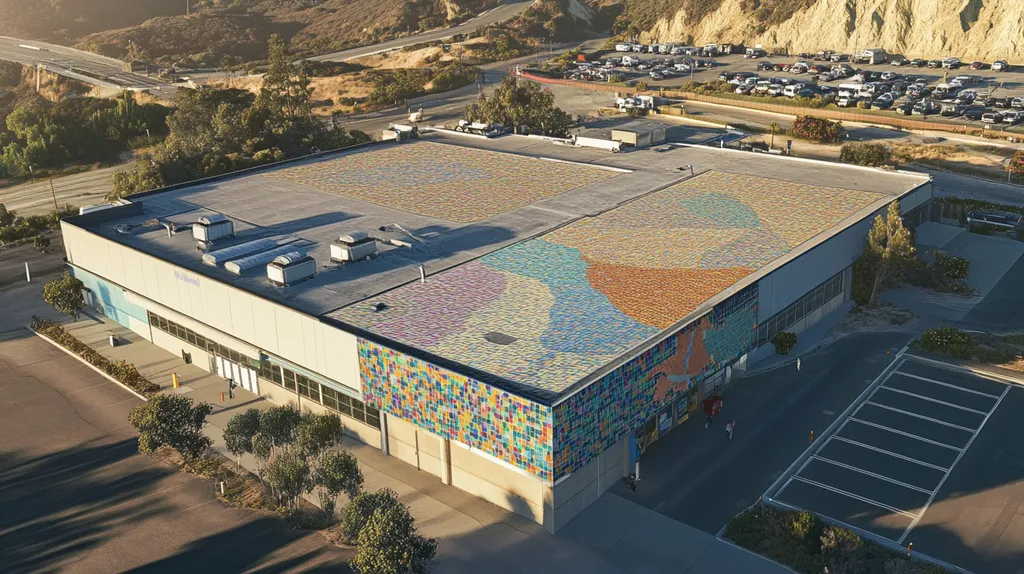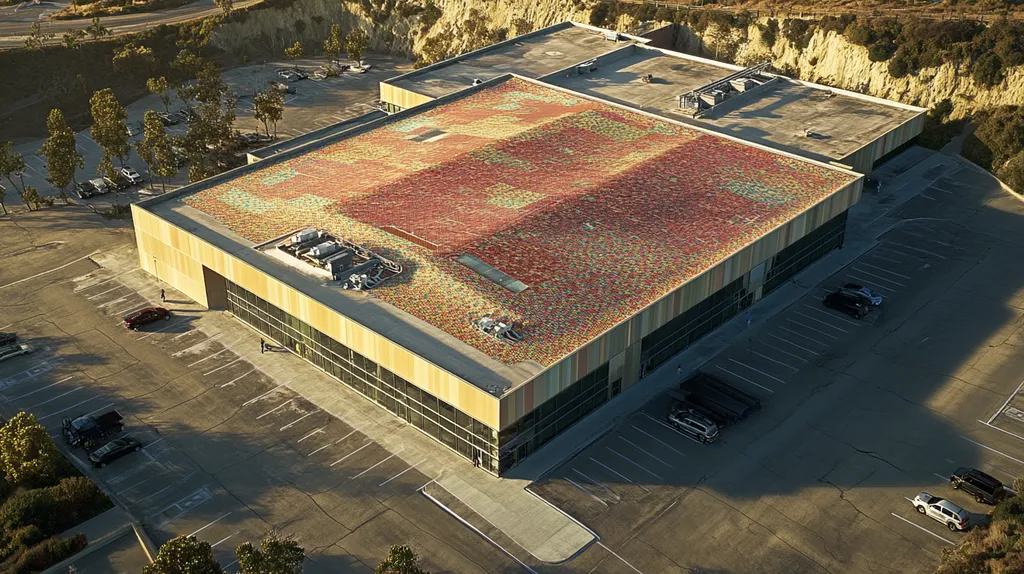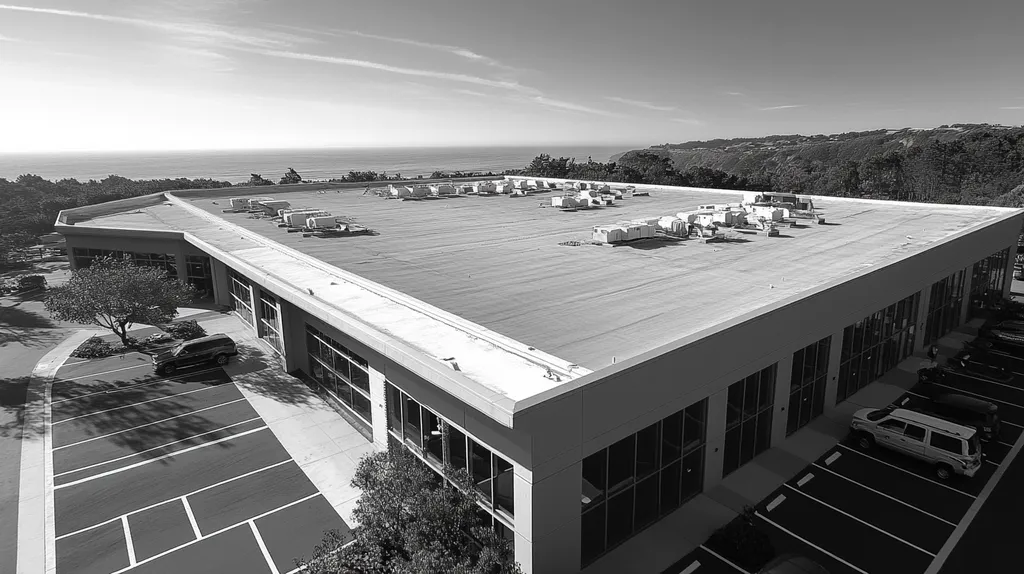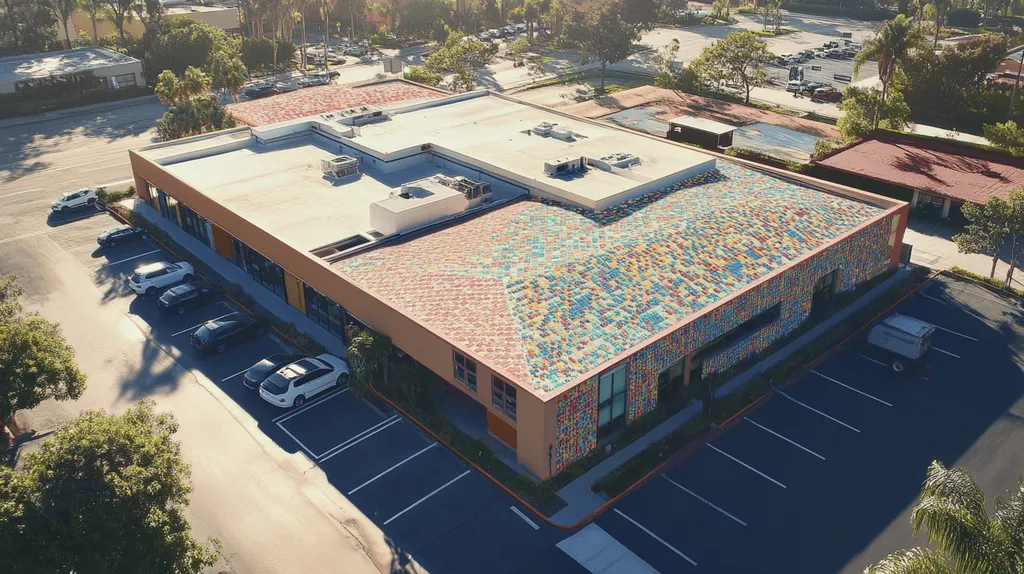The commercial roofing industry faces a critical challenge as mounting evidence suggests current VOC standards may be fundamentally flawed. With over 90% of volatile organic compounds eliminated from roof coatings in recent decades, coating performance and durability have declined dramatically.
Property owners and facility managers now confront an impossible choice between regulatory compliance and optimal roof protection. Studies indicate ultra-low VOC formulations require recoating up to 40% more frequently than their moderate-VOC counterparts.
This article examines how accepted VOC level standards emerged, why they fall short, and what alternatives could better serve both environmental and performance goals.
SECTION 1: CURRENT PRACTICES
The commercial roofing industry stands at a critical crossroads regarding volatile organic compounds (VOCs) in roof coatings. While regulatory compliance drives current practices, mounting evidence suggests accepted standards may be inadequate for protecting building occupants and the environment. The delicate balance between coating performance and VOC content impacts everything from application methods to long-term roof durability.
Overview of VOC Regulations in U.S. Roofing Coatings
Federal and state regulations have created a complex landscape of VOC requirements that vary by region. The Environmental Protection Agency establishes baseline standards, while local air quality management districts often impose stricter limits.
California’s regulations remain the most stringent, with the South Coast Air Quality Management District limiting VOCs to 50 grams per liter for most roofing products. Other states have adopted similar but less restrictive standards.
This regulatory patchwork creates challenges for national manufacturers and contractors who must navigate different requirements across jurisdictions. Many opt to formulate products meeting the strictest standards to ensure universal compliance.
Understanding these regulations helps property owners make informed decisions about coating selection and application timing. However, mere compliance with current standards may not guarantee optimal safety or performance.
Common VOC Content Limits and Compliance Methods
Over the past several decades, the roofing industry has dramatically reduced VOC content in coatings by up to 90%. These compounds serve essential functions, providing freeze-thaw resistance during shipping and improving adhesion during application. (source: Roof Coatings Manufacturers Association)
Manufacturers typically demonstrate compliance through independent laboratory testing and detailed product labeling. These tests measure VOC content under standardized conditions, though real-world emissions may vary.
Current limits focus primarily on initial VOC content rather than long-term emissions. This approach may overlook the cumulative impact of VOCs released throughout the coating’s lifetime.
While meeting regulatory requirements, many compliant products still contain significant VOC levels that could affect indoor air quality and worker safety during application.
Role of VOCs in Roof Coating Performance and Application
VOCs contribute significantly to coating workability and cure times. Their presence allows for smooth application and proper film formation, particularly in challenging weather conditions.
Lower VOC formulations often require careful attention to application temperature and humidity ranges. These restrictions can limit installation windows and potentially impact project scheduling.
The drive toward reduced VOC content has spurred innovation in coating chemistry. New technologies aim to maintain performance while minimizing environmental impact.
Property owners must weigh immediate application benefits against long-term health and environmental considerations. Understanding this balance helps inform coating selection and application timing decisions.
SECTION 2: SYSTEMIC ISSUES
The evolution of commercial roof coatings mirrors the broader transformation of industrial chemistry over the past half-century. Today’s systemic challenges stem from a complex interplay of regulatory requirements, performance demands, and environmental concerns. These issues trace back to the industry’s rapid transition away from traditional solvent-based formulations, creating a landscape where coating effectiveness often conflicts with compliance standards.
Inconsistencies Across State and Local VOC Standards
State-by-state variations in VOC regulations have created an intricate mosaic of compliance requirements. While some regions maintain strict 50g/L limits, others allow up to 250g/L, leading to significant disparities in coating formulations and performance across markets.
These regulatory differences force manufacturers to maintain multiple product lines, often with varying performance characteristics. The result is a fragmented market where coating quality depends more on location than actual building needs.
The challenge extends beyond mere product formulation. Installation crews must adapt their application techniques based on local VOC restrictions, potentially compromising coating integrity.
This regulatory patchwork has effectively created different tiers of roof protection across regions, with some buildings receiving superior coatings while others make do with compromised alternatives.
Impact of VOC Limits on Coating Durability and Adhesion
The dramatic reduction in VOC content has fundamentally altered coating chemistry. Over 90% of VOCs have been eliminated from roof coatings in recent decades, affecting crucial properties like freeze-thaw resistance during shipping and adhesion during application. (source: Roof Coatings Manufacturers Association)
Contemporary low-VOC formulations often struggle to achieve the same level of substrate penetration and bonding as their higher-VOC predecessors. This limitation becomes particularly evident in cold weather applications or on challenging surfaces.
Performance issues frequently manifest as reduced water resistance and shorter coating lifespans. Buildings in harsh climates face accelerated degradation when coatings lack the necessary durability properties.
The cost implications extend beyond initial application, as maintenance cycles must be shortened to compensate for reduced coating longevity.
Regulatory Complexity and Industry Compliance Challenges
The current regulatory framework places an overwhelming burden on facilities managers and contractors. Documentation requirements alone can consume significant resources, often requiring specialized expertise to interpret and implement.
Weather windows for coating application have narrowed considerably under stricter VOC guidelines. This restriction forces many projects into suboptimal timing, potentially compromising installation quality.
Training requirements have intensified as application procedures become more technically demanding. Crews must master complex chemical interactions while maintaining efficiency under tighter environmental constraints.
The cumulative effect creates scenarios where perfect compliance may conflict with optimal roof protection, leaving building owners to navigate an increasingly challenging decision-making process.
SECTION 3: MISSED OPPORTUNITIES
The commercial roofing industry stands at a critical inflection point regarding VOC standards. In our rush to embrace ultra-low VOC formulations, we risk overlooking decades of proven coating performance characteristics. The pendulum has swung so far toward VOC reduction that essential functional properties are being compromised, leading to shorter roof lifespans and increased maintenance costs. Today’s facility managers face tough decisions between environmental compliance and roof system longevity.
Overlooked Benefits of Moderate VOC Levels in Coatings
Traditional coating formulations with moderate VOC levels offered distinct advantages in penetration and adhesion that many modern ultra-low VOC products struggle to match. These characteristics were particularly valuable on aged roof surfaces where deep penetration could restore weathered membranes.
Moderate VOC coatings historically demonstrated superior resistance to ponding water and UV degradation. Their molecular structure allowed for better cross-linking during curing, creating a more durable protective barrier.
Over the last few decades, ninety percent of VOC content has been eliminated from roof coatings. VOCs help protect roof coatings during shipment by providing freeze thaw resistance and improve adhesion on the jobsite. (source: Roof Coatings Manufacturers Association)
The drive toward ultra-low VOC formulations has inadvertently compromised these performance benefits. Many facility managers now face more frequent recoating cycles as modern products fail to deliver the same longevity.
Potential for Innovation in Low-VOC Formulations
Recent advances in polymer science suggest promising alternatives that could bridge the performance gap. New hybrid technologies combining traditional resins with bio-based materials show potential for maintaining crucial coating properties while reducing VOC content.
Emerging nanotechnology applications may offer solutions for enhancing penetration and adhesion without relying on volatile compounds. These innovations could revolutionize how coatings interact with roof surfaces at the molecular level.
Smart coating technologies incorporating phase-change materials and self-healing properties represent another frontier. These developments could compensate for some performance losses associated with VOC reduction.
The key lies in funding and accelerating research into these alternative technologies. Without sustained investment in innovation, the industry risks stagnating with underperforming products.
Opportunities to Harmonize Regulations for Industry Efficiency
The current patchwork of state and regional VOC regulations creates unnecessary complexity and cost. A unified national standard would allow manufacturers to focus resources on developing better-performing products rather than managing multiple formulations.
Standardized testing protocols could provide more meaningful performance data across different coating types. This would help facility managers make more informed decisions based on actual field performance rather than just VOC content.
Streamlined approval processes for new coating technologies could accelerate innovation. Many promising developments currently face lengthy review periods under varying regulatory frameworks.
Harmonization efforts should focus on finding the optimal balance between environmental protection and coating performance. The goal must be sustainable solutions that truly serve both purposes.
SECTION 4: ROOT CAUSES
The stakes are high when it comes to understanding VOC levels in commercial roof coatings. Inadequate knowledge can lead to poor decision-making, resulting in negative impacts on both air quality and roof performance. According to the EPA, about 25% of VOC emissions in urban areas stem from products like roofing materials. This highlights an urgent need to reassess current VOC standards, which have not evolved with scientific advancements. The following sections will explore the historical context, the influence of air quality policies, and the limitations of existing VOC measurement methods.
Historical Basis for Current VOC Level Standards
The roots of current VOC level standards date back several decades. Initially, these regulations were established during a time when the primary focus was on immediate public health concerns related to air quality. As technology and science evolve, however, these historical benchmarks have not kept pace with new findings. Many materials previously deemed acceptable may now contain higher concentrations of VOCs than considered safe based on current knowledge.
This disconnect means that property owners often rely on outdated practices in selecting roof coatings. For example, standards set in the 1970s did not account for enhancements in material compositions that today feature more efficient and sustainable solutions. Consequently, adhering to these legacy standards may compromise both performance and environmental integrity.
With scientific advancements, the understanding of the long-term effects of VOC exposure on both the environment and human health has significantly progressed. Thus, a reevaluation of these outdated standards is crucial for ensuring modern coatings contribute positively to air quality while fulfilling technical requirements.
Furthermore, many manufacturers still design coatings to meet these historical standards rather than focusing on improving the overall formulation for better health and environmental outcomes. This stagnation creates an industry-wide reluctance to innovate, leaving property owners with fewer options for safer, high-performing roofing solutions.
Influence of Air Quality Policies on Coating Regulations
Air quality policies have played a vital role in shaping VOC regulations for roof coatings. Federal and state regulations often focus on reducing overall emissions to combat smog and improve public health. While this focus is essential, it frequently overlooks the specific needs and nuances of commercial roofing. Property owners may struggle to find coatings that meet these regulations yet still deliver top-notch performance.
For instance, the Clean Air Act led to stringent limits on VOC emissions from various products, including those used in roofing. However, many of these limits are often set without considering the latest advancements in material science. This has resulted in an industry-wide push toward compliant but potentially less effective products.
In addition, local air quality plans can vary dramatically from one region to another. This creates confusion among property owners about which products meet regional regulations. The push for compliance can overshadow the need for innovation, making it challenging to prioritize effective, quality coatings.
Thus, while air quality policies are critical for public health, they can inadvertently stifle advancements in roofing material technology. The roofing industry needs regulations that encourage not just compliance but also innovation to offer safer, more effective options to property owners.
Limitations in VOC Measurement and Classification Methods
The methods used to measure and classify VOC emissions are another area of concern. Traditional measurement techniques often do not account for the complexity of modern roofing materials. Many testing methods focus only on specific compounds, resulting in a misleading understanding of overall emissions. Consequently, property owners might select coatings that meet specific limits but could still release harmful substances in use.
Moreover, the classification of VOCs can sometimes misinterpret various chemical formulations. For instance, some products might be classified as low-VOC based on outdated measurements that do not reflect their actual impact in real-world conditions. This inconsistency can mislead property owners and facility managers when making informed decisions for their roofing needs.
As the industry moves toward more environmentally friendly solutions, it is crucial to adopt new, precise measurement techniques. Better measurement and classification methods would empower property owners to make more informed choices that align with modern environmental and health standards.
Adopting advanced testing protocols could lead to more transparent labeling and marketing of roofing products. This transparency would allow property owners to prioritize both VOC compliance and roof safety in their selection processes, ultimately benefiting the industry as a whole.
DATA DRIVEN EVIDENCE
The relationship between VOC content and roof coating performance demands urgent attention from property owners and facility managers. Field studies spanning decades reveal a complex interplay between environmental compliance and system longevity. As coating technologies evolve, evidence suggests that overly restrictive VOC limits may compromise critical performance characteristics, leading to premature failures and increased lifecycle costs.
Empirical Studies on VOC Impact on Roof Coating Longevity
Long-term performance studies indicate that coatings with moderately higher VOC content often demonstrate superior weathering characteristics. Laboratory testing shows these formulations achieve deeper substrate penetration and form more robust protective barriers.
Field observations across diverse climate zones reveal that ultra-low VOC coatings frequently require reapplication 30-40% sooner than their moderate-VOC counterparts. This accelerated deterioration directly impacts maintenance budgets and overall roof protection.
Over the last few decades, ninety percent of VOC content has been eliminated from roof coatings. VOCs help protect roof coatings during shipment by providing freeze thaw resistance and improve adhesion on the jobsite. (source: Roof Coatings Manufacturers Association)
Coating adhesion strength measurements demonstrate that moderate-VOC formulations maintain better long-term bonding to common roofing substrates. This enhanced adhesion proves particularly valuable in preventing premature coating failure during extreme weather events.
Comparative Analysis of VOC Regulation Outcomes by Region
Regional variations in VOC regulations create natural experimental conditions for analyzing coating performance. Markets with strict 50g/L limits show significantly higher recoating frequencies compared to areas allowing 250g/L formulations.
Building portfolios spanning multiple jurisdictions provide clear evidence that stricter VOC limits often correlate with reduced coating durability. Properties in regions with moderate VOC allowances consistently demonstrate longer coating service lives.
Climate zone analysis reveals that VOC-related performance gaps become more pronounced in extreme environments. Coating failures occur up to 60% more frequently in strict-regulation regions experiencing severe weather conditions.
Economic impact studies indicate that aggressive VOC restrictions can increase total roof maintenance costs by 25-35% over a typical building lifecycle. These additional expenses stem primarily from more frequent recoating requirements.
Quantitative Assessment of VOC Reductions vs. Roof Performance
Statistical analysis of coating performance metrics shows an inverse correlation between VOC reductions and key durability indicators. As VOC content decreases below certain thresholds, measurable declines occur in water resistance, flexibility, and adhesion strength.
Temperature mapping studies demonstrate that ultra-low VOC coatings often provide less effective thermal protection. This reduced performance can increase building energy consumption by 10-15% compared to moderate-VOC alternatives.
Lifecycle assessments indicate that the environmental benefits of extreme VOC reductions may be offset by increased material consumption. More frequent recoating cycles generate additional waste and require more raw materials over time.
Cost-benefit analyses suggest optimal VOC levels exist where coating longevity and environmental impact achieve better balance. These optimal points typically fall between current strict limits and historical levels.
SECTION 6: ALTERNATIVE SOLUTIONS
As commercial roofing technology evolves, the limitations of current VOC standards become increasingly apparent. The industry finds itself at a pivotal moment where traditional coating solutions no longer align with modern environmental and performance demands. Property owners face mounting pressure to adopt safer alternatives while maintaining roof system integrity. The path forward requires embracing advanced materials, establishing consistent regulations, and following evidence-based guidelines that optimize both safety and longevity.
Advanced Low-VOC Coating Technologies and Materials
Over the last few decades, ninety percent of VOC content has been eliminated from roof coatings. VOCs help protect roof coatings during shipment by providing freeze thaw resistance and improve adhesion on the jobsite. (source: Roof Coatings Manufacturers Association)
Emerging polymer technologies now offer promising alternatives that maintain critical performance characteristics while dramatically reducing emissions. These next-generation formulations incorporate novel cross-linking agents that achieve superior adhesion without relying on traditional volatile compounds.
Water-based acrylic dispersions represent another breakthrough, delivering excellent UV resistance and weatherability. These systems create robust protective barriers through advanced particle technology rather than solvent evaporation.
Recent developments in hybrid coating chemistry combine the best attributes of different material families. These innovations provide enhanced durability and application flexibility while maintaining ultra-low VOC profiles.
Integrated Regulatory Frameworks for Consistent Standards
The fragmented nature of current VOC regulations creates unnecessary complexity and drives up costs across the industry. A unified approach would eliminate conflicting requirements while maintaining environmental protection.
Performance-based standards offer a more practical framework than arbitrary VOC limits. This approach would evaluate coatings based on their actual environmental impact throughout their service life rather than just initial content.
Regional climate considerations should factor into regulatory requirements. Standards could adjust for temperature, humidity, and other environmental factors that influence coating behavior.
Streamlined approval processes for innovative low-VOC technologies would accelerate adoption of safer alternatives. Currently, many promising solutions face lengthy review periods under varying jurisdictional requirements.
Data-Supported Guidelines for Optimizing VOC Levels and Performance
Evidence-based decision tools help property owners evaluate the true environmental impact of different coating options. These resources consider factors beyond simple VOC content, including durability, maintenance requirements, and energy efficiency.
Life-cycle assessment models reveal that moderately higher initial VOC levels may result in lower total emissions when accounting for coating longevity. This holistic view helps identify optimal solutions for specific building conditions.
Predictive analytics now enable more accurate forecasting of coating performance under various conditions. This capability allows facility managers to better plan maintenance schedules and budget for long-term roof protection.
Performance monitoring systems provide real-time data on coating behavior and environmental impact. These insights drive continuous improvement in both product formulation and application practices.
Moving Forward
With over 90% of VOCs eliminated from commercial roof coatings in recent decades, the industry faces a critical inflection point that demands immediate action.
Current standards force an impossible choice between environmental compliance and roof system performance, as ultra-low VOC formulations require up to 40% more frequent recoating.
The path forward requires harmonizing regulations across jurisdictions while embracing emerging technologies like hybrid polymers and smart coatings that maintain performance without relying on traditional VOCs.
Until regulatory frameworks evolve to reflect modern coating chemistry, property owners must carefully weigh shortened maintenance cycles against strict VOC compliance.
The stakes for building protection and occupant safety are simply too high to continue accepting compromised coating performance in pursuit of arbitrary VOC limits.
FREQUENTLY ASKED QUESTIONS
Q. What are the current VOC practices for commercial roof coatings?
A. The commercial roofing industry is navigating complex VOC regulations that prioritize compliance. While current standards ensure basic safety, many coatings still contain harmful VOC levels, potentially impacting indoor air quality and application safety. Understanding these regulations helps property owners make better choices for coating selection and application.
Q. How do state VOC standards affect industrial roof performance?
A. Significant variations in VOC regulations across states lead to inconsistent coating performance. Manufacturers may have to produce multiple formulations, causing discrepancies in protective qualities based on location. This regulatory patchwork can compromise the performance of coatings, affecting durability and effectiveness on different properties.
Q. What benefits are there to moderate VOC levels in commercial roofs?
A. Moderate VOC levels in coatings can enhance penetration and adhesion, especially on aged roofs. These coatings historically show better resistance to ponding water and UV degradation, extending roof life and decreasing maintenance frequencies. However, newer low-VOC products may not match these critical performance characteristics.
Q. How do VOC levels relate to roof coating longevity?
A. Studies indicate that coatings with moderate VOC levels provide superior weathering performance, requiring less frequent reapplication. In turn, reduced lifespans in ultra-low VOC coatings can lead to increased maintenance costs and decreased durability, affecting the overall value of the roofing system.
Q. What systemic issues are present in industrial roofing regulations?
A. The transition away from traditional solvent-based coatings has created systemic challenges. Regulatory demands often limit the performance of current products, complicating installation processes. This environment pressures facility managers toward compliance without ensuring they select coatings that truly protect their roofs over time.
Q. What innovations are emerging in low-VOC roofing technologies?
A. New polymer technologies are advancing low-VOC roofing solutions without sacrificing performance. Innovations combining traditional materials with bio-based components offer enhanced durability. Additionally, hybrid coatings and advanced formulations are being developed to ensure compliance while improving protection against the elements.
Q. How can property owners assess roof coating performance effectively?
A. Property owners can evaluate performance through evidence-based guidelines and lifecycle assessments. Considering factors beyond VOC levels, such as durability and thermal efficiency, helps in making informed decisions. Data-supported tools can aid in identifying solutions tailored to the specific needs of their roofs.










